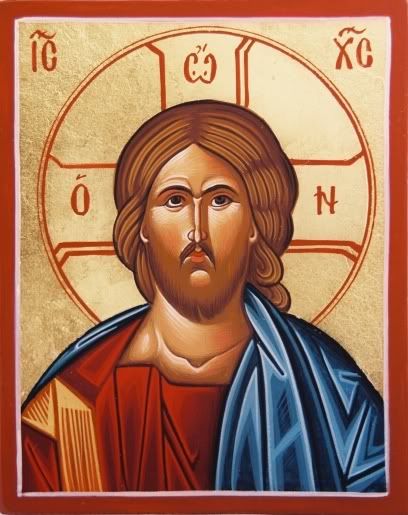The post also appeared in Black Looks, and for that one the WordPress trackback worked in my Khanya blog, but it seems that the Poéfrika one was the earlier mention, so I thought I would link to it here as well. I think Orthodox Christians would have problems with both the first image and the second image in the meme, and would say that neither looked like Jesus.
For Orthodox Christians the true image of Jesus is more like this (acknowledgements to my daughter, who painted the ikon):

In Orthodox ikonography Jesus is shown as a Near Eastern man, not Nordic (blond and blue-eyed), nor Caucasian (like Stalin), nor African, nor Aryan (like the first image). Jesus Christ is one person (hypostasis) and so images depicting him according to any artist's imagination depart from the truth. The "My Jesus" type of Picture, creating a Jesus according to one's own desires and perceptions and values (whether of colour, complexion, or anything else) depicts a fantasy Jesus.
An ikon, however, is not a photograph. It does not show you what you would have seen if you had been there. It shows, rather, what most people did not see -- that this is the incarnate Son of God. Ikons show Christ (and the saints) with elongated noses, not as some kind of aesthetic ideal, but to show that they breathe the air of heaven. They have small feet, because they tread lightly upon the earth. Christ's clothing is red and blue, to show the divine and human natures, but in one person. But he still looks Near Eastern, just as ikons of St Peter the Aleut show him as Aleutian, and those of St Moses the Black show him as African. Jesus Christ was a real person, not someone's conception of an idealised type of humanity.
7 comments:
Talented daughter. That's a magnificent piece of work. I'll have to ask my children what they think of that one.
Thanks for picking this up and commenting it.
Thanks for the comment - I'd be interested in knowing what your kids think of it.
That question really mattered to me about twenty years ago. I think that our image of what Jesus did look like is mainly influenced by the Shroud of Turin in Western AND Eastern art. The fact that his appearance is never described maybe a proof that there was nothing unusual about his looks. The fact that a spy was needed to identify him indicates that he just looked like the fishermen and blue collar workers surrounding him.
The fact that Paul despises long hair in 1 Corinthians 11:14 indicates that he had no long hair at all.
So he may have looked like this.
Zep,
The example you gave was given in the original post I was commenting on, which has now been plagiarised by another web site: Poéfrika: PLAGIARISM!.
i know this has nothing to do with the fact but on the poll results it says recommended by a fried
I'm sorry, but the Russian Orthodox tradition usually depicts Jesus in the same manner as any non-Orthodox European nation does, so I suppose your statement doesn't apply to all Christian Orthodoxy. Here is a Russian Nordic Jesus, for instance: http://www.ikony.ru/products_pictures/i52076.jpg
In most Byzantine icons Jesus belongs to the same phenotype that other citizens of the empire belong to. In fact, he looks even more European than them. He has elongated, elegant features, a narrow nose, and light-brown hair.
Anonymous,
There are Russian ikons that depict a "Nordic" Jesus, though I think the one at the link you posted wasn't a particularly good example.
Some Russian churches, especially those built in the 19th century, have ikons painted in a Western baroque or rococo style, but I think most would agree that these are not good examples of Orthodox ikonography.
Ikons are usually painted with unnaturally narrow noses and unnaturally small feet. They are not meant to be naturalistic depiction, but a theological statement.
Post a Comment